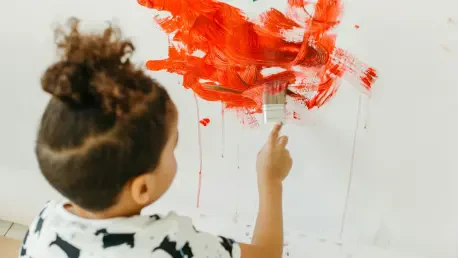In a world where the formative years of a child’s life are increasingly recognized as pivotal for long-term development, it is disheartening to see early childhood arts being sidelined in policy discussions, despite their critical role in shaping young minds. This specialized field, which focuses on creative engagement with children under three, plays a vital role in fostering emotional and cultural growth. Yet, despite its significance, the sector struggles with systemic neglect, chronic underfunding, and a lack of recognition within broader educational and cultural frameworks. Freelance artists and cultural workers, who dedicate their careers to nurturing young minds through art, often find themselves isolated and unsupported. A recent report by Magic Acorns, funded by Arts Council England, brings these challenges to light, drawing on insights from nearly 100 professionals. Their findings reveal a workforce rich in expertise but hindered by policy gaps, urging a reevaluation of how society values and sustains this critical area of early years development.
Systemic Neglect in Cultural Frameworks
The marginalization of early childhood arts within national policy is a persistent barrier to its growth and sustainability. Despite the fact that 60% of practitioners surveyed have over a decade of experience, and 80% work directly with children from birth to three, their expertise is rarely acknowledged in cultural or educational strategies. This exclusion results in a fragmented workforce, where professionals lack the connectivity and institutional support needed to thrive. The emotionally responsive nature of their work, tailored to the unique needs of very young children, demands a level of specialization that is often misunderstood or undervalued by policymakers. Short-term, competitive funding models exacerbate the issue, prioritizing measurable outcomes over the creative process that lies at the heart of their practice. Without a seat at the policy table, these practitioners struggle to advocate for the resources and recognition their field desperately needs, leaving the sector vulnerable to further erosion over time.
Moreover, the institutional neglect faced by early childhood arts extends beyond policy exclusion to a deeper lack of understanding about its value. Practitioners report that their contributions are frequently seen as supplementary rather than foundational to a child’s development. This perception undermines the profound impact that creative engagement can have on emotional and social growth during the earliest years. Dr. Jessica Pitt, co-director of Magic Acorns, argues that early childhood arts should be viewed as a cornerstone of cultural development in the UK, not a peripheral activity. The constant state of peril in which the sector operates, due to limited career pathways and insufficient resources, hinders professional growth and innovation. Without systemic change, the risk of losing this vital field looms large, depriving future generations of the benefits that come from early exposure to the arts and the nurturing environments these practitioners create.
Funding Challenges and Workforce Precarity
Chronic underfunding remains one of the most pressing issues facing early childhood arts, placing practitioners in a precarious financial and professional position. Many of these workers, often self-employed, rely on sporadic grants and short-term projects to sustain their careers, with little to no stability in sight. The competitive nature of funding applications means that only a fraction of initiatives receive support, leaving many talented individuals unable to continue their work. This instability not only affects livelihoods but also stifles the potential for long-term projects that could have a lasting impact on young children and their families. The lack of sustained investment creates a vicious cycle, where practitioners are forced to prioritize immediate survival over strategic development, further weakening the sector’s ability to advocate for itself on a national stage and build a robust foundation for future growth.
Adding to the funding woes is the absence of structured career pathways for those in early childhood arts, which limits opportunities for professional advancement. The report highlights how the workforce, despite its depth of experience, struggles with inadequate training resources and support systems to pass on expertise to the next generation. Stories from seasoned practitioners, such as a veteran artist with 25 years in puppetry for under-fives, reveal the frustration of seeing their work undervalued by those outside the field. Partnerships with nurseries and libraries often falter due to a lack of understanding about the nuanced, sometimes chaotic nature of creative play with very young children. The call for better training for educators and community workers who collaborate with artists is loud and clear, as is the need for funding to pilot innovative programs. Without addressing these structural deficiencies, the sector risks losing its most dedicated contributors, whose passion and skill are essential to its survival.
Bridging the Gap with Actionable Solutions
To address the myriad challenges facing early childhood arts, the establishment of a national network for practitioners emerges as a promising solution. Such a network would provide a platform for collaboration, skill-sharing, and knowledge exchange among a largely self-employed workforce that often operates in isolation. By fostering a sense of community, this initiative could empower artists to collectively advocate for policy changes and secure the resources they need. The report suggests that connecting professionals across regions would also help standardize best practices, ensuring that the quality of creative engagement remains high regardless of location. Arts Council England has expressed alignment with this vision through their Let’s Create strategy, which emphasizes accessible, high-quality creative activities for young children. Their commitment to exploring these recommendations signals a potential shift toward greater support and integration of early years arts into national priorities.
Beyond networking, the report advocates for targeted funding to pilot creative teaching programs that can train emerging practitioners and preserve existing expertise. This approach would not only address the shortage of career pathways but also ensure that innovative methods are passed down effectively. Investing in research to map early years arts provision across the country is another critical step, as it would provide a clearer picture of where gaps exist and how to address them. The real-world struggles of practitioners, who often juggle multiple roles to reach diverse audiences, underscore the urgency of these measures. Supporting partnerships between artists and early years settings, such as nurseries and libraries, through dedicated resources and training, could further elevate the impact of their work. These actionable steps, taken in the past, laid the groundwork for a more resilient sector, and their continued implementation remains essential to safeguarding the future of early childhood arts for generations to come.









